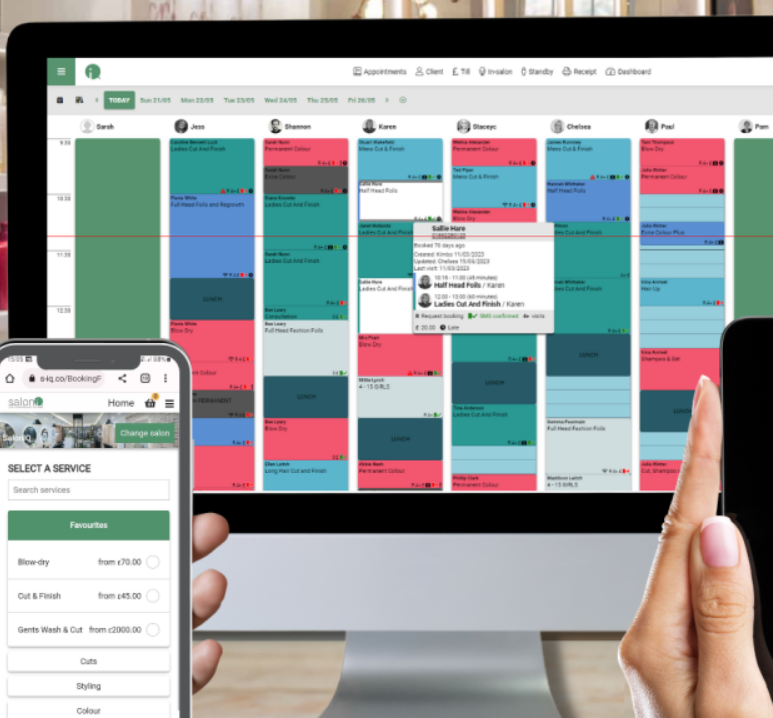Salon owners often face the challenge of finding software that works well with their current systems. A red flag to watch for is compatibility issues that arise from outdated hardware or operating systems. Software that requires significant upgrades or replacements might be more trouble than it’s worth. It’s key to assess whether the software supports all existing devices and if it can integrate smoothly without causing disruptions.
Another important factor is the software’s ability to handle your salon’s specific demands. Look for indications that the software may be too generic and lacks features tailored to your needs. This might include lacking important functions like appointment or customer relationship management. For those just starting, you can click here to find solutions that provide an all-in-one package, possibly at no cost, which might be more appropriate.
Additionally, check for hidden fees and limitations, which can be a significant deterrent. Software that advertises low prices but includes extra charges for necessary features can quickly become expensive. Identifying red flags early on can prevent the hassle of a poor software choice and help you select a solution that truly supports your business objectives.
Technical Compatibility
Technical compatibility is important when choosing salon software to make sure it works smoothly with your current system. Key areas to focus on include the software’s ability to integrate with the operating system, connect with existing hardware, and synchronize with databases.
Operating System Integration
A necessary step in checking compatibility is guaranteeing that the salon software integrates well with the operating system already used in the salon. Different software applications may function differently depending on whether the system is Windows, macOS, or a Linux variant. It’s important first to verify if the operating system supports the software and whether a specific version is required to run smoothly.
Compatibility issues may arise if the software needs a newer operating system version than what is currently installed. This can lead to performance glitches or the application not launching at all. Upgrading the operating system or choosing software with wider OS support can help avoid these problems.
Hardware Connectivity
The function of salon software often depends on its ability to connect with various hardware devices used in the salon. Compatible software should link seamlessly with equipment like printers, barcode scanners, and payment terminals, staples in many salons. This connectivity is necessary to guarantee smooth operations.
Before acquiring new software, testing its compatibility with existing hardware and checking if possible driver updates are needed is beneficial. This helps reduce the need for additional equipment purchases. Incompatibility can increase costs if new hardware must be purchased or existing devices need frequent troubleshooting.
Database Synchronization
Proper synchronization with databases is another aspect to consider to guarantee optimal use of salon software. Most salon operations rely on large amounts of data, such as customer information, appointment schedules, and payment records. The software should effectively synchronize with existing databases to manage this information efficiently.
Evaluating software that supports common database types, like SQL or cloud-based solutions, can help maintain seamless data management. Software that struggles with database compatibility may lead to data loss or duplication, affecting customer service and salon operations. Testing the software’s data handling capabilities before full implementation can minimize risks associated with poor synchronization.
User Experience and Functionality
When choosing salon software, it’s important to evaluate its easy use and whether it meets all the requirements for the salon’s daily operations. Considering how the software can adapt to future growth needs is also beneficial.
Ease of Use
Salon software should be intuitive for both salon staff and clients. A straightforward user interface helps reduce training time and minimizes errors during daily tasks. Look for features like clear navigation menus, simple appointment scheduling, and seamless checkout processes.
User-friendly software also increases productivity. Employees can focus more on customer service rather than troubleshooting technical issues. Additionally, clients will appreciate a smooth experience when booking services online or checking in at the salon.
Feature Completeness
A software package that includes all necessary features is important for salon operations. This might include appointment scheduling, inventory management, and customer profiles. Make sure that the software you choose supports all necessary functions.
Having to use separate tools for different tasks can be inefficient. An integrated system streamlines processes and reduces the chance of data errors. It’s also convenient for staff to access all information from one platform.
Customization Capabilities
Each salon has unique needs, so the ability to customize software features can be beneficial. Look for options that allow adjustments to scheduling rules, service menus, and customer notifications. This guarantees the software works the way your salon needs it to.
Customization can also help with branding. Adjusting the interface to match the salon’s aesthetic can improve the customer experience. This personal touch can make the software feel uniquely tailored to your business.
Scalability for Business Growth
As a salon grows, it’s important that its software can grow with it. This includes the ability to handle more clients, staff, and services. Choose a software solution that supports expansion without losing performance.
Scalability also involves adding new functions or integrating with other systems as the business evolves. Consider software that offers different plans or add-ons to suit changing business needs. This flexibility can save time and costs in the long run.
Conclusion
Recognizing red flags when evaluating salon software compatibility is important. Guaranteeing integration is seamless helps avoid potential disruptions in operations.
Several warning signs highlight potential issues. These include software that lacks important data transfer capabilities. Also, systems with poor user reviews often signal trouble.
Assessing the compatibility of features and functionalities helps identify potential challenges. It aids in maintaining efficient salon operations without unnecessary disruptions.














